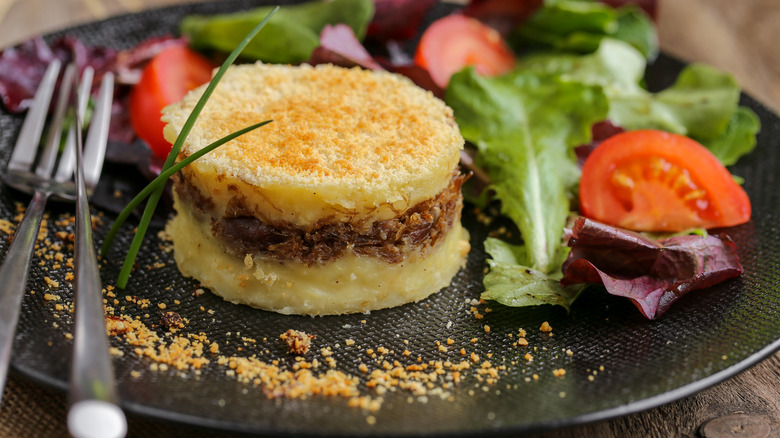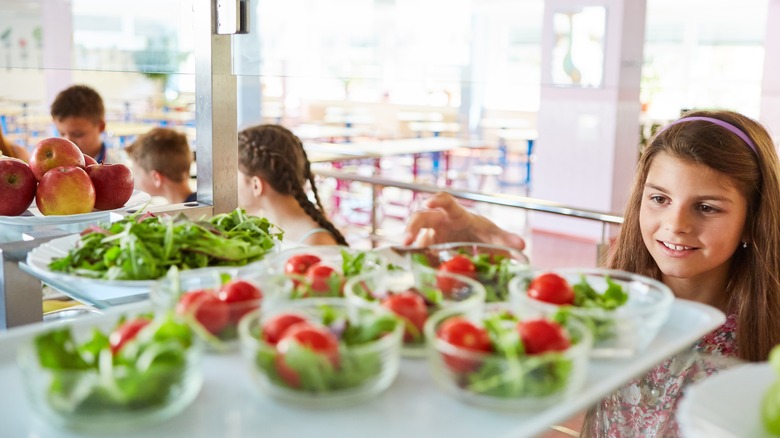How French School Lunch Stacks Up To American School Lunch
It's well-documented that American school lunches often aren't the most nutritious meals around. Options like pizza, chicken nuggets, burgers, and tater tots abound. Head across the Atlantic to France, and school lunches there are a parallel universe; they come with multiple courses, often including a vegetable or salad, a hot main dish, bread and cheese, and a dessert (this is often fruit, but is sometimes a sweet treat like apple crumble or a cake).
Offerings vary between schools and regions, but could include beet salad, French classics like duck confit parmentier, confit carrots, or even grilled guinea fowl. To drink, water is standard, rather than juice or milk. They're not perfect — for example, French schools without kitchens may get lower-quality, mass-produced food from a centralized kitchen elsewhere — but generally speaking, it's a fancy affair.
Of course, the exact school lunch offerings also vary across the U.S. For example, while chocolate milk and crispy chicken sandwiches may appear on menus in both New York City and South Carolina, there seem to be some more nutritious options in NYC, such as bean curry or roasted zucchini, while a South Carolina school may serve burgers, nachos, tater tots, and meatball subs. One report from ProCare Therapy suggests that Louisiana has the worst school lunches when it comes to well-balanced, nutritious meals, with the most popular lunch item there being fried chicken. Hawaii is considered among the most nutritious, with options like stir-fries and kimchi.
Why are school lunches in France so different?
There are some key cultural differences as to why French school lunches are so elaborate. In line with France's generally leisurely lunch breaks, students have more time to eat — at least 30 minutes per day, often more. French kids also tend to be fed more or less the same food as adults, so there's not a culture of serving "kid-friendly" foods like chicken nuggets. But France also has fairly strict nutritional requirements for school lunches. The French Ministry of Education sets firm limits on how many fried meals can be served per month at a school (four out of about 20 meals), and only three desserts per month can be high in fat. Ketchup is mostly banned from school cafeterias.
While the U.S. also has nutritional requirements, these have sometimes been bent — for example, an infamous 2011 rule change that allowed pizza to count as a serving of vegetables, due to its tomato sauce. This may be because American funding for school lunches is a serious problem (and seems to be getting worse in the era of post-COVID inflation). Fewer than one in five schools report that their federal funding is sufficient to cover the costs of the meals they're providing, and many schools have trouble finding staff for cafeterias. This lack of funding and workers forces schools to buy processed food that's easier to prepare and cheaper than fresh produce — hence the often low quality of American school lunches.
How American school lunches can change
Politics plays a role in why American school lunches are often lower-quality than those in France. More funding or stricter nutritional guidelines would obviously help, but these would generally need to be passed by Congress or individual states. Some politicians have pushed changes through, like Obama's Healthy, Hunger-Free Kids Act in 2012, while others, such as Trump, sought to loosen the nutritional rules for school lunches in 2018 (although this was overturned in 2020).
Of course, it's a careful balancing act. The 2012 changes aimed to improve the nutritional value of school lunches, but it turns out that you can't always force kids to eat that way. Some reports suggest that food introduced after this act was more likely to be thrown away, with kids sometimes just bringing their own food to school instead.
But there are other groups trying to change American school lunch culture. An organization called Brigaid, led by former Noma chef Dan Giusti, has sought to provide better-rounded meals in schools, focusing on more disadvantaged areas — for example, the Bronx — and cooking dishes like roast chicken or hummus that could appeal to kids. It's not flawless — Giusti has reportedly had difficulty finding staff — but it's still done at a low cost with funding from the National School Lunch Program, proving that tight budgets don't make nuggets and fries an inevitable part of school menus.


